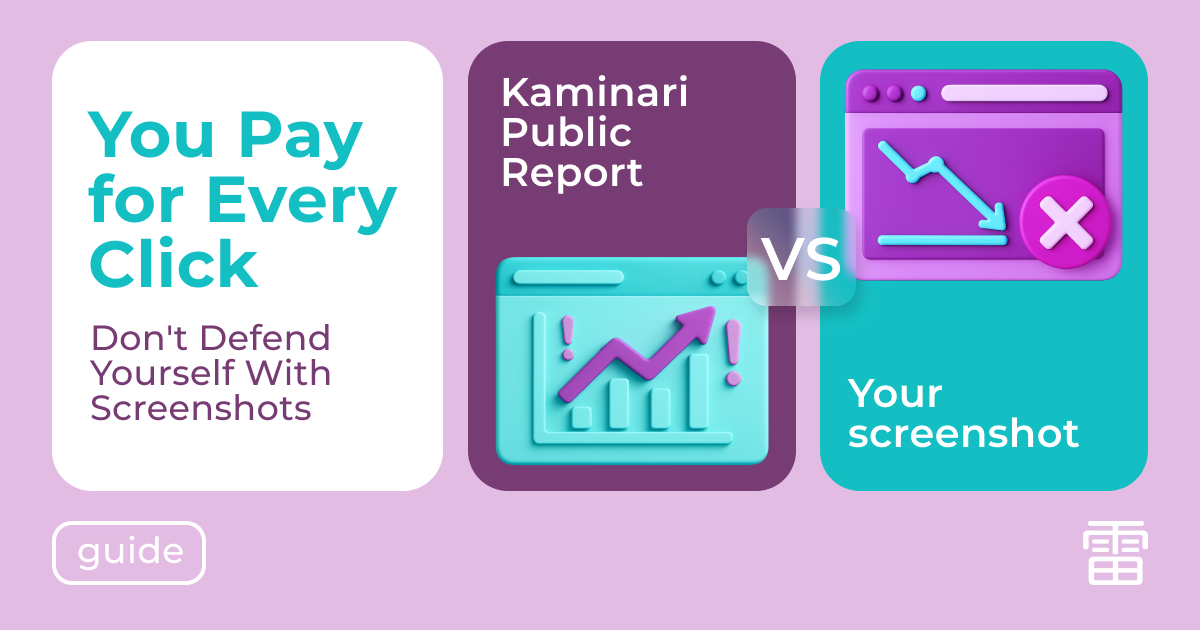If you work with traffic, you’ve definitely faced this: your antifraud system shows anomalies, and the supplier responds with:
“We’re clean. It’s your tool that’s buggy.”
So what should you do?
How do you move the conversation to facts, not emotions?
And how do you get real action — like a refund or traffic replacement?
At Kaminari Click, we regularly support clients in such cases and help them defend their budgets.
Below is a step-by-step guide on how to use Public Report, communicate your position professionally, and get compensation — without conflict.
1. “We have 35% fraud” — is a weak argument
Numbers without context are not proof — they’re emotion.
A standard supplier response is:
“Your antifraud calculates it wrong.”
“We have no issues. Check your redirect.”
What actually works:
– Detailed breakdown for each click: user-agent, source, IP, behavior
– Identified patterns: repeated technical parameters, overheated subs
– Timeline of anomalies: when the spike started, from which sources, under what conditions
– Behavioral signals: scroll = 0, bounce rate = 100%, time on page < 1 sec
Example:
You bought 1.2 million clicks. 38% flagged as fraud.
Instead of saying “we have 38% fraud,” you present a report:
– 97% of anomalies came from 3 subs
– All with spoofed user-agents
– Identical behavior — as if from the same script
This is no longer a complaint — it’s a documented inconsistency.
2. Public Report: the key to a transparent conversation
In Kaminari, you can generate a public report in one click — and share a link with real data, not just screenshots.
What to include in the report:
– Total number of clicks and fraud rate
– Suspicious subIDs and their structure
– Block reasons (VPN, bots, data center, spoofed agent, etc.)
– Behavioral signals and click examples
– Raw logs for each click (clickId, referrer, IP, user-agent)
Example:
(screenshot/case study here)
Such a report is hard to ignore:
– the data is transparent,
– the logs are real,
– the clicks are yours.
The “this is a bug” excuse doesn’t work anymore.
3. How to write the message properly
Your goal is not to blame — but to start a focused conversation.
Aggressive wording kills any chance of compensation.
Here’s a message structure that works:
Message example:
“Hi,
We use the Kaminari Click antifraud system and noticed abnormal traffic behavior from several of your sources.
Summary by subs:
– xml_feed_43: 12,317 clicks — 8,314 marked as automated (same user-agents, noscroll, bounce = 100%)
– pop_source_vpn: 6,210 clicks — 71% through VPN/proxy
Report attached.
Could this be related to tests or a change in sources? We’re open to discussing compensation or traffic replacement. Looking forward to your response.”
It sounds polite — but it’s a clear, evidence-based complaint.
No emotion, only facts.
4. How to respond to common excuses
“We use our own antifraud — no issues on our side”
Show your behavioral metrics.
If the clicks are “clean,” why aren’t they converting?
“It’s your landers or redirects”
Run an A/B test with another source and compare CR.
The issue is either on your side or in the traffic — and you’ll find out.
“Your antifraud blocks everything”
The report clearly shows filtering logic.
Include a link — show that the logic is transparent.
5. How to get a refund or replacement
Step 1 — Numbers. Don’t ask for a refund without data and specifics.
Step 2 — Dialogue. Don’t accuse — clarify the source, conditions, testing.
Step 3 — Documentation.
If you agree on something: confirm volumes, timing, subs in writing.
Use CRM notes, tracking, and emails.
What increases your chances:
– Breakdown by day, sub, source
– ClickID and full click logs
– Analytics screenshots (CR, bounce, session time)
– Involving the advertiser or a third party
6. What if the partner doesn’t respond?
If your partner ignores or stalls, apply protection measures:
– Auto-block subs with fraud — stop burning the budget
– Mark as “risky partner” in CRM — and exclude from trusted networks
– A/B test other providers — to show a clear difference
– Discuss the case publicly in the community — sometimes transparency helps resolve it faster
Conclusion: Antifraud isn’t just a “filter” — it’s protection for your money
Kaminari Click isn’t just about blocking fraud. It’s about:
– Transparency in traffic buying
– Budget protection and evidence in negotiations
– Improving quality with accurate analytics
You pay for every click.
You have the right to know what you’re actually buying.
What to do if something already feels “off”
If your CR has dropped, bounce rate has spiked, or you feel like “traffic isn’t working” — don’t wait for losses.
Book a free demo — we’ll show you what’s happening.
With data. Not emotions.
We’ll prepare the report.
You’ll make the decision.

